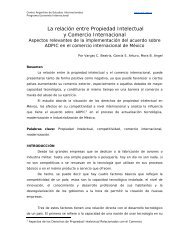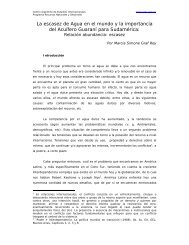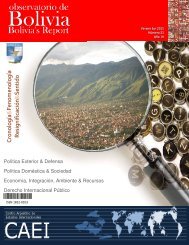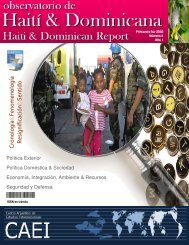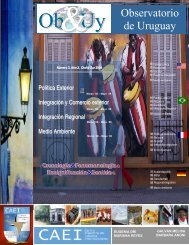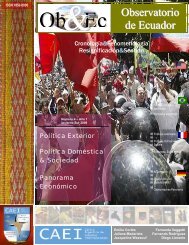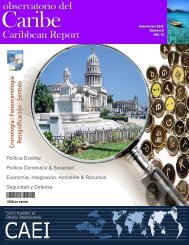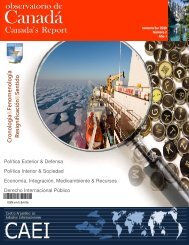Brazil's Defense Industry: The Emerging Transformational ... - CAEI
Brazil's Defense Industry: The Emerging Transformational ... - CAEI
Brazil's Defense Industry: The Emerging Transformational ... - CAEI
You also want an ePaper? Increase the reach of your titles
YUMPU automatically turns print PDFs into web optimized ePapers that Google loves.
ased on the inter-industry linkages with geographic proximity. Henderson (1974) 5 also emphasizes<br />
the agglomerative effects of positive spillovers between firms in geographic proximity. Spatial<br />
economics provides the base for Michael Porter’s prominent book “the Competitive Advantages of<br />
Nations” (1990), indisputably contributing to the avalanche of (re)definitions of industrial complex and<br />
clusters expanding his “Diamond of Advantages” framework for identifying national competitive<br />
advantages.<br />
<strong>The</strong> difference between the interrelated concepts of cluster and industrial complex is interpreted in<br />
Czamansky and Ablas (1979:62) conceptualization: “… cluster is a subset of industries connected by<br />
flows of goods and services stronger than those linking them to the other sectors of the national<br />
economy. <strong>The</strong> concept is thus devoid of any spatial connotation. A complex, on the other hand, has<br />
been defined as a group of industries connected by important flows of goods and services, and<br />
showing in addition a significant similarity in their locational pattern. Thus, complexes emphasize the<br />
spatial aspect of industrial concentration.” However, vom Hofe and Chen (2006:19) 6 point out that<br />
“other scholars have applied cluster-based methods to recommend regional economic development<br />
strategies, analyzing industrial clusters as spatial phenomena rather than a sole operating economic<br />
grouping of industries.”<br />
<strong>The</strong> field of industrial complexes and clusters has come a long way since Izard conceptualized the<br />
industrial district. But the naming and classification of clusters and complex still remains, at least to<br />
some extent, without general consensus.<br />
To formulate higher-level propositions on the basis of empirical observations, this paper aims to<br />
describe, evaluate (measure), and recommend policy alternatives by offering operational definitions<br />
for the terms defense industrial base, defense industrial complex, and defense industrial clusters:<br />
<strong>Defense</strong> Industrial Base refers to the national capacity of the industry sector to develop and sustain<br />
peace- and war-time defense needs. <strong>Defense</strong> Industrial Complex is reserved for the aggregation of<br />
interrelated groups (subsystems) of industrial capabilities within geographic boundaries. <strong>The</strong> defense<br />
complex is part of the Brazilian <strong>Defense</strong> Industrial Base. <strong>Defense</strong> Industrial Cluster is used to qualify<br />
groups of highly interrelated value chains within categories based on technology specificities. An<br />
example using these concepts would be the UAV (Unmanned Aerial Vehicles) cluster of Sao Jose<br />
dos Campos lodge inside the <strong>Defense</strong> Aerospace Complex of the Brazilian Industrial Base.<br />
<strong>The</strong> defense industrial base, with its complex and clusters, is a national resource that makes up a<br />
significant portion of the overall deterrent and defense posture. Brazil cannot afford to ignore it or to<br />
allow it to deteriorate, nor should Brazil allow it to reemerge with dysfunctional structure, or<br />
inadequate correlation with national development. While this subject has undoubtedly been<br />
breached, it has mostly been in relation to isolated cases rather than a more widely-considered<br />
response to the general paradigmatic shift impulse from Brazil’s rising power.<br />
5 Henderson, J.V. <strong>The</strong> Sizes and Types of Cities. American Economic Review, 64, pg:640-56, 1974.<br />
6 Vom Hofe, R. and Chen, K. Whither or not Industrial Cluster: Conclusions or Confusions? <strong>The</strong> Industrial Geographer,<br />
Volume 4, issue 1, pg: 2-28, 2006.<br />
4<br />
Todos los derechos reservados. - Pág. 4





